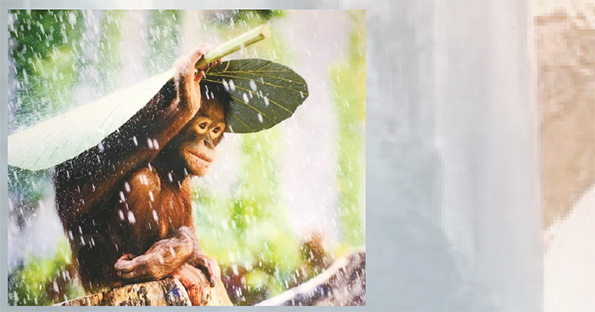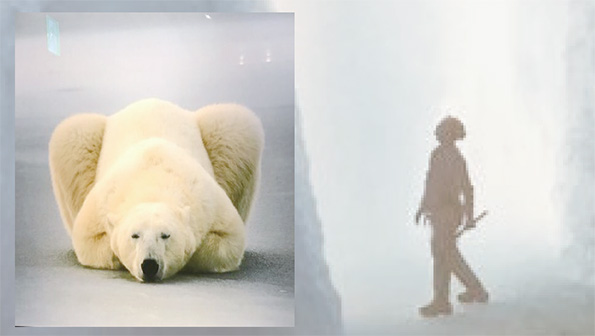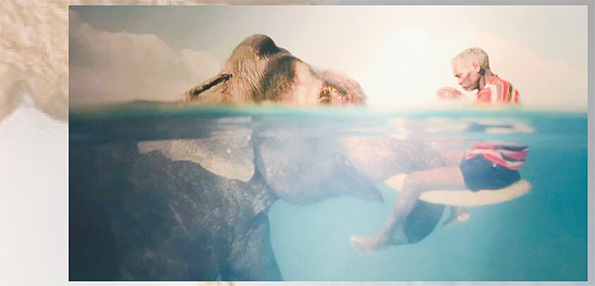
These days, most people can hardly afford to take a moment to enjoy the scenery outside the window. Also, it is not easy to pay attention to anything because they are so engrossed in the work that surrounds them. There isn’t much time to think about the people around them, the environment, or even the Earth. However, in places where people live together, things should be in harmony, and it is very important to protect the Earth and to coexist together. The National Geographic Photographic Exhibition highlights these themes, and it provides an opportunity for us to look at the Earth, the human race, and their surroundings.
< Zone 1: The Pale Blue Dot>
The exhibition begins with the phrase, “The Earth we live on is a tiny dot in the dark of the great universe. We must save and preserve this pale blue dot, the only place of life, in a more modest manner.” Zone 1 of the exhibition is adorned with photographs of Dr. Carl Sagan’s explorations and photographs showing that the Earth is only a tiny fraction of the universe. It is said that the Earth, photographed by Voyager 1 near Pluto on February 14th, 1990 at the request of Dr. Carl Sagan, looked like a pale blue dot. The photo shows that the only place where humans live in the vast universe is the Earth, which is a tiny dot. People have always thought of nature and humanity in relation to the Earth, and they have rarely thought of the Earth in relation to the vast universe. The only planet people live on is the Earth, and they are able to realize how important it is to protect it.
< Zone 2: The Great Steps >
The Great Steps is an area where photos from when the National Geographic Society was founded in 1888 are displayed, and it displays record-breaking photographs of the past 131 years. It contains scenes of nature and anthropological records from the views of humans. Among them, the most memorable pictures are the National Geographic flag and three deer running in surprise. The flag is blue, brown and green, which symbolize the sea, the earth, and the sky. It is impressive that one little flag seems to encompass the meaning of the place we live and the importance of protecting it. The picture of the three deer jumping in surprise was captured by a device designed to flash when animals trigger a wire trap. At first sight, the dynamic photo is quite impressive, but when people see the explanation of the picture, they aren’t so impressed anymore because it seems a little bit cruel to shoot them with an unmanned device that startled them. The Great Steps is an exhibition hall containing the history of National Geographic, but it is also a place to rethink human’s selfishness towards nature.
<Zone 3: Open Eyes>
Nature is a great sculptor and creator, and it makes weird and unique things that can’t be imitated. This zone displays awe-inspiring photographs of nature. A picture of a geologist collecting lava samples shows the vastness of lava extrusions in comparison with humans, and it depicts the dynamic energy of nature, which seems to cover the world with heat. Also, there is a photograph of a man standing on the sand and fish swimming in the lake. The photo was shot with half of the lens submerged in a lake. This technique is marvelous and has the symbolism of human’s coexistence with nature. Visitors can also enjoy photographs of galaxies that are visible only in uncontaminated darkness, a beluga whale making air bubbles with its mouth, and the Grand Plasma Spring, which was created by microbes.
<Zone 4: Heart to Heart>
In the last zone, pictures of the relationship between life and nature are shown. There are many funny pictures of various animals including a monkey using a big leaf to avoid rain, a lion that seems to be considerate, a polar bear resting in a flexible posture, and rabbits having a snowball fight. Also, photos of a giraffe popping its head into a car window and trainers sitting on elephant tusks show the communion between humans and animals. These photographs become more interesting after reading the descriptions. Because a trainer taught elephants how to swim and to carry logs, there is a picture of the trainer sitting on a swimming elephant. However, some of the works depict humans’ thoughts about the polluted environment. These interesting photographs show how nature has been destroyed by people who pollute it with reckless development. These photographs, including a mother and a child on a pile of garbage, micro-plastics gleaming in the water, and a Laysan albatross bird which has a plastic-filled belly, emphasize the seriousness of environmental pollution. In particular, the appearance of the Laysan albatross bird is shocking. The bird is trying to catch a squid floating on the surface, but it mistakes micro-plastic for a squid.
The Earth we live on is a temporary rental, and people must coexist with other creatures on the Earth. However, people often turn their backs on nature for the sake of convenience. The exhibition is awe-inspiring, and it helps to educate people that nature is being destroyed. These days, people are immersed in their work, but this exhibition can help them focus more on the environment. CBT reporters hope to prevent the further destruction of nature.
By Kim Min-ji
mj39@cbnu.ac.kr
By Lee Dong-ah
da39@cbnu.ac.kr



 All
All Experience
Experience






 Kim Min-ji & Lee Dong-ah
Kim Min-ji & Lee Dong-ah











